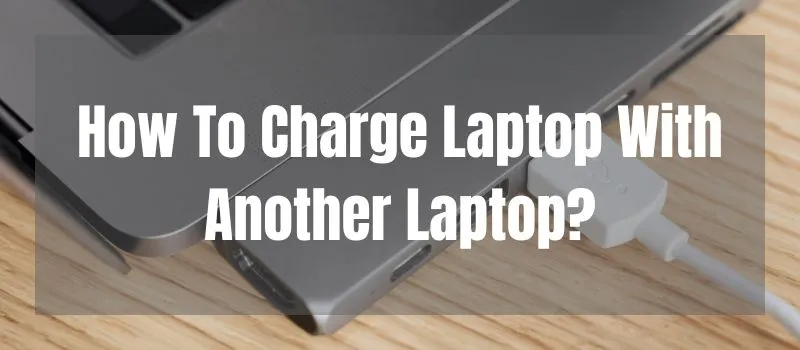Yes, you can use an external power source to recharge your laptop’s battery. It’s possible to charge your laptop using a variety of methods other than the one built into the device. For those looking for a portable solution, external laptop battery chargers and power banks are popular options.
There are other options besides these external charging options. Using universal power adapters that can charge multiple devices, including laptops, is advised by some industry experts. These adapters frequently feature a variety of interchangeable tips that enable them to work with different laptop models.
You can charge your laptop battery using one of these adapters instead of the original charger. These external charging options could come in handy if you’re always on the go or don’t have access to outlets. We’ll explore the different external charging methods in greater detail.
We’ll discuss the pros and cons of each option, provide tips for selecting the right charger or power bank, and address common concerns and misconceptions. So, if you’re curious about how to charge your laptop battery externally and want to learn more about the available options.
Table of Contents
Can We Charge Laptop Battery Externally?
Charging a laptop battery externally is indeed possible and can be a convenient solution in certain situations. One method to achieve this is by using an external battery charger. By directly connecting the charger to the laptop battery, you can bypass the laptop itself and maximize the current flow.
This can be beneficial for those who need to charge their laptop battery quickly or when the laptop is not available for charging. Using an external battery charger offers flexibility and portability. You can charge the battery separately without having to rely on the laptop’s charging port or power adapter.
This means you can charge the battery while using your laptop for other tasks or even when the laptop is turned off. It’s a handy option for people who are frequently on the go or in situations where access to a power outlet may be limited. It’s important to ensure compatibility between the external battery charger and your laptop model.
Different laptops may have different battery types and connectors, so it’s crucial to choose a charger that is specifically designed for your laptop. This will help prevent any potential issues or damage to your laptop battery. Charging a laptop battery externally using an external battery charger can provide a practical solution for users who need more flexibility and convenience.
It allows for faster charging and an independent power supply, making it a great option for those on the move or in situations where a power outlet is not readily available. Just remember to select a compatible charger to ensure a safe and efficient charging experience.
Understanding the need for external charging
The need to charge a laptop battery externally arises when you find yourself in a situation where access to a power outlet is limited or unavailable. This could happen while traveling, camping, or during a power outage. External charging options provide a convenient way to keep your laptop powered when traditional charging methods are not viable.
Exploring the options
When it comes to charging a laptop battery externally, there are several options available. Each option has its own advantages, limitations, and compatibility considerations. Let’s take a closer look at some popular choices:
Power Banks: A Portable Solution
How do power banks work?
Power banks, also known as portable chargers, are compact devices that store electrical energy in built-in batteries. They can be charged in advance and used to charge various devices, including laptops, on the go. Power banks typically come with multiple USB ports, allowing you to connect your laptop and other devices simultaneously.
Choosing The Right Power Bank For Your Laptop
Selecting the right power bank for your laptop is crucial to ensure compatibility and efficient charging. Consider the following factors when choosing a power bank:
Capacity:
Look for a power bank with sufficient capacity to charge your laptop fully at least once. Check your laptop’s battery capacity (measured in watt-hours) and compare it with the power bank’s capacity.
Output voltage and current:
Ensure that the power bank’s output voltage and current are compatible with your laptop’s requirements. Most laptops require 19V output, but it’s essential to verify this information in your laptop’s specifications.
Portability:
Consider the size and weight of the power bank, especially if you plan to carry it with you frequently. Look for compact and lightweight options that are convenient to travel with.
Now, let’s move on to another external charging option.
Solar Chargers: Harnessing The Power Of The Sun
Benefits Of Solar Chargers
Solar chargers utilize sunlight to generate electricity, offering an eco-friendly and renewable way to charge your laptop. They are particularly useful in outdoor environments where access to traditional power sources is limited. Here are some benefits of using solar chargers:
Portability:
Solar chargers are lightweight and portable, making them ideal for outdoor activities such as camping, hiking, or working in remote locations.
Environmental sustainability:
By harnessing solar energy, you reduce your carbon footprint and contribute to a cleaner environment.
Emergency backup:
Solar chargers can be a valuable resource during emergencies or power outages when traditional power sources are unavailable.
Considerations For Using Solar Chargers
While solar chargers offer great benefits, it’s important to consider a few factors before investing in one:
Sunlight availability:
Solar chargers require direct sunlight for optimal charging. If you live in an area with limited sunlight or frequently encounter cloudy weather, the charging efficiency may be reduced.
Charging time:
The time it takes to charge your laptop with a solar charger depends on factors such as sunlight intensity, panel efficiency, and the battery capacity of your laptop. It’s important to manage your expectations and plan accordingly.
Compatibility:
Ensure that the solar charger you choose is compatible with your laptop’s charging requirements. Some laptops may require a higher input voltage or have specific connector types, so verify compatibility before making a purchase.
Let’s now explore another external charging option that offers versatility and convenience.
USB-C Charging: Versatility At Its Best
Introduction to USB-C charging
USB-C (Universal Serial Bus Type-C) is a versatile and widely adopted charging standard that allows you to charge various devices, including laptops, tablets, and smartphones. Many modern laptops feature USB-C ports, providing a convenient option for external charging. Here are some key advantages of USB-C charging:
Single cable solution:
USB-C charging eliminates the need for multiple chargers and cables. You can use a single USB-C cable to charge your laptop, transfer data, and connect to other peripherals.
Fast charging capabilities:
USB-C supports Power Delivery (PD), a technology that enables faster charging by delivering higher power output. This means you can charge your laptop more quickly compared to traditional charging methods.
Compatibility And Limitations
While USB-C charging offers great versatility, it’s essential to consider compatibility and limitations:
Power Delivery support:
Not all USB-C ports on laptops support Power Delivery. Ensure that your laptop’s USB-C port is capable of delivering power before attempting to charge it externally.
Power requirements:
USB-C charging relies on the power capabilities of the charger and the laptop. Make sure the charger can provide sufficient power to charge your laptop effectively. Refer to your laptop’s specifications for the required power input.
Now that we’ve explored USB-C charging, let’s move on to another external charging option.
External Battery Chargers: Dedicated Charging Devices
What are external battery chargers?
External battery chargers, also known as laptop chargers or charging docks, are dedicated devices designed to charge laptop batteries externally. These chargers provide a more efficient and specialized charging solution compared to power banks or other generic charging options. They often come with multiple ports, allowing you to charge multiple laptops simultaneously.
Using External Battery Chargers Effectively
To make the most of your external battery charger, consider the following tips:
Compatibility:
Ensure that the external battery charger is compatible with your laptop’s battery model and specifications. Verify the compatibility details offered by the charger’s manufacturer.
Safety precautions:
Follow the manufacturer’s instructions and safety guidelines when using external battery chargers. Improper usage can lead to damage to the charger, or laptop, or even pose a safety risk.
Charging time:
External battery chargers typically have faster charging capabilities compared to traditional laptop chargers. Charging times may still vary depending on factors such as battery capacity and the charging current provided by the charger.
Now that we’ve covered external battery chargers, let’s explore another charging option that offers convenience on the go.
Car Chargers: Power On The Go
Charging your laptop in a vehicle
Car chargers, also known as car adapters or inverters, allow you to charge your laptop while on the move. They plug into your vehicle’s cigarette lighter socket and provide power to your laptop. Car chargers are particularly useful during long road trips, business travels, or when you spend a significant amount of time in your vehicle.
Safety Precautions
When using a car charger to charge your laptop, it’s important to follow these safety precautions:
Choose a reliable car charger:
Invest in a high-quality car charger that is designed for laptop charging. Avoid using generic or low-quality car chargers, as they may not provide a stable power supply or can damage your laptop.
Don’t charge while driving:
It’s strongly recommended not to charge your laptop while driving. Focus on the road and avoid any distractions. Instead, charge your laptop when the vehicle is stationary or during designated breaks.
Ensure proper ventilation:
Laptops can generate heat during charging. Make sure the laptop is placed in a well-ventilated area to prevent overheating. Avoid covering the laptop or obstructing its airflow.
Now that we’ve covered car chargers, let’s explore some out-of-the-box solutions for charging a laptop externally.
Diy Solutions: Thinking Outside The Box
MacGyvering your way to a charged laptop
In situations where traditional charging options are unavailable, you can get creative and explore DIY solutions to charge your laptop externally. Here are a few examples:
Power inverter from a car battery:
If you have access to a car battery and a power inverter, you can use them to convert the DC power from the battery into AC power to charge your laptop.
DC power source:
Some laptops have the option to connect to a DC power source, such as a car battery or a solar panel, directly. Check your laptop’s specifications or consult the manufacturer to determine if this is possible.
Assessing the risks involved
While DIY solutions can be resourceful, it’s important to assess the risks involved and exercise caution:
Safety hazards:
DIY solutions may involve handling electrical components, which can be dangerous if not done properly. Always prioritize your safety and follow proper procedures when working with electricity.
Damage to the laptop:
Using unconventional charging methods carries the risk of damaging your laptop’s battery or internal components. Proceed with caution and be aware of the potential consequences.
Warranty considerations:
DIY charging methods may void your laptop’s warranty. Consider the warranty implications before attempting any unconventional charging methods.
Now that we’ve explored various external charging options, let’s move on to answering some frequently asked questions.
Frequently Asked Questions
How long does it take to charge a laptop battery externally?
The charging time for a laptop battery externally depends on various factors, such as the charging method, battery capacity, and the power output of the charger. Generally, external charging methods can be faster than traditional charging methods, but the exact time will vary. Refer to the manufacturer’s specifications for estimated charging times.
Can I use any power bank to charge my laptop?
Not all power banks are suitable for charging laptops. Laptops typically require a higher power output compared to smartphones or tablets. Ensure that the power bank you choose has sufficient capacity and the required voltage and current output to charge your specific laptop model. Check the power bank’s specifications or consult with the manufacturer to verify compatibility.
Is it safe to charge a laptop battery with a solar charger?
Charging a laptop battery with a solar charger can be safe if you use a solar charger specifically designed for laptop charging and follow safety guidelines. Ensure that the solar charger is compatible with your laptop’s charging requirements and provides stable power output. Avoid exposing the laptop to extreme temperatures or direct sunlight for extended periods.
Can I charge my laptop using a car charger while driving?
Charging your laptop using a car charger while driving is not recommended for safety reasons. It’s important to stay focused on the road and avoid distractions. Instead, charge your laptop when the vehicle is stationary or during designated breaks.
What are the potential risks of DIY charging solutions?
DIY charging solutions carry various risks, including electrical hazards, potential damage to the laptop or its components, and warranty voiding. It’s important to assess the risks involved and proceed with caution. If possible, consult with a professional or seek manufacturer-approved solutions to ensure safety and avoid potential issues.
Can I charge my laptop battery externally while it’s turned on?
Yes, you can charge your laptop battery externally while it’s turned on. Keep in mind that charging a laptop while it’s in use may result in slower charging times due to the simultaneous power consumption by the laptop’s components. If you need to charge your laptop quickly, it’s advisable to turn it off or put it in sleep mode during the charging process.
Conclusion
In conclusion, the ability to charge a laptop battery externally offers convenience and flexibility, especially in circumstances where conventional charging methods are not easily accessible. Alternatives include things like power banks, solar chargers, USB-C charging, external battery chargers, car chargers, and even do-it-yourself solutions.
When investigating external charging options, it’s critical to take compatibility, safety precautions, and potential risks into account. To ensure the best charging experience, constantly refer to your laptop’s specifications, seek manufacturer advice as needed, and put safety first.
Read More:




